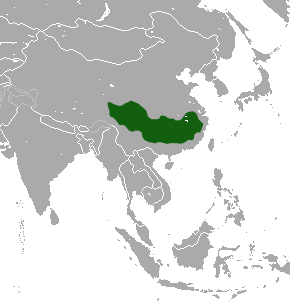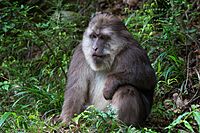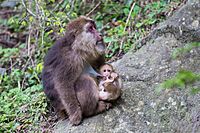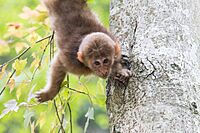Tibetan macaque facts for kids
Quick facts for kids Tibetan macaque |
|
|---|---|
 |
|
| An elderly female on Mount Emei, Sichuan, China | |
| Conservation status | |
| Scientific classification | |
| Genus: |
Macaca
|
| Species: |
thibetana
|
 |
|
| Tibetan macaque range | |
The Tibetan macaque (Macaca thibetana) is a type of macaque monkey. You can find them in parts of China, from eastern Tibet all the way to Guangdong and north to Shaanxi. They have also been seen in northeastern India. These monkeys live in warm, wet forests, both where trees lose their leaves and where they stay green all year. They prefer to live high up, between 800 to 2,500 meters (about 2,600 to 8,200 feet) above sea level.
Contents
About the Tibetan Macaque
The Tibetan macaque is the biggest kind of macaque and one of the largest monkeys in Asia! Only the proboscis monkey and some larger types of gray langur are bigger.
What They Look Like
Male Tibetan macaques are larger than females. Males usually weigh from 13 to 19.5 kilograms (about 29 to 43 pounds) and are 61 to 71 centimeters (about 24 to 28 inches) long. The heaviest male ever recorded weighed 30 kilograms (about 66 pounds)! Females are smaller, weighing 9 to 13 kilograms (about 20 to 29 pounds) and measuring 49 to 63 centimeters (about 19 to 25 inches) long. Their tails are short and stubby, only 4 to 14 centimeters (about 1.5 to 5.5 inches) long, with females having even shorter tails.
Their fur is thick and long, which helps them stay warm in cold places. It's brown on their backs and creamy-buff or gray underneath. Some adults have very dark brown fur, while others are a sandy yellowish-brown. They have a noticeable, light-colored beard and long whiskers, but their faces don't have much hair. Males have pale pink faces, but females have a brighter, reddish-pink face. Baby macaques are born with silver and black fur, which changes to their adult color when they are about two years old.
How They Live
Tibetan macaques live in groups with both males and females. In their social system, female macaques usually stay with the group they were born into for their whole lives. However, males leave their birth group when they become teenagers, around eight years old.
Macaque groups have a pecking order, meaning some monkeys are more important than others. Higher-ranking males get better access to things like food and female partners. The "alpha male" is the leader of the group. These males are usually big, strong, and newly grown up. As males get older, they often lose their top spot and other males might challenge them for leadership. These fights can be very violent, and sometimes males can even die in battle. Studies of Tibetan macaques at Mount Emei and Huangshan Mountains in China showed that an alpha male usually only stays in charge for about one year.
When a group gets too big (around 40 to 50 monkeys) and there isn't enough food for everyone, some individuals (males, females, and young ones) will leave the main group. They form a new, smaller group and find a different area to live in. Usually, it's the monkeys with the lowest rank in the group who leave.
Reproduction and Family Life
Female macaques usually have their first baby when they are about five years old. They are pregnant for six months and usually have one baby at a time. Most babies are born in January and February. Young macaques drink their mother's milk for about a year, and sometimes longer if the mother doesn't have another baby the next year. Interestingly, males in the group might also help take care of the young, which is called "alloparental care."
These monkeys are active during the day. They spend most of their time on the ground, looking for food. They eat leaves, fruit, grass, and sometimes flowers, seeds, roots, and insects. They especially love bamboo shoots, fruits, and leaves when they can find them.
Protecting Tibetan Macaques
The Tibetan macaque is listed as "Near Threatened" by the IUCN, which means they could become endangered in the future if we don't protect them. They are also listed on Appendix II of the CITES list, which helps control their trade.
Their biggest problems come from humans. They are very sensitive to habitat destruction, which means their forest homes are being destroyed. Sometimes, they can get sick from diseases that humans carry. They might also be poisoned by chemicals like herbicides and pesticides if they eat plants that have been sprayed. Sadly, some people also hunt them illegally for their meat and fur.





